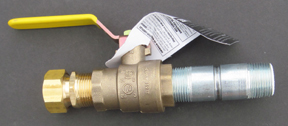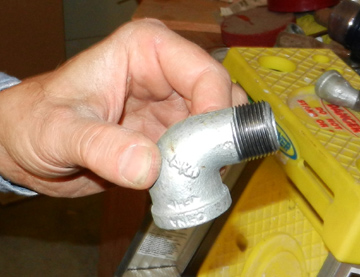
Water Heaters 101 > Drain Valves
What you'll find on this page: All water heaters have drain valves. What are they there for? Are they all created equal?

Every water heater has a drain valve. Very many people buy a water heater and never go near that valve. And that's a good thing. We won't truly say it's just there for show, but if you tried to use it, you might be frustrated. Usually they are cheap plastic affairs. Two are shown in the picture at right. The top one is called a cone valve, while the bottom one is a simple spigot type. Some heaters come with a brass spigot.
Why does it matter? For some people, it won't matter at all. Others will have read the instructions and decided they should drain their heaters from time to time, as the instructions say, to prevent sediment buildup. Still others will have learned that too much sediment in an electric heater will burn out the lower element, and they, also, will try to drain the tank. That's when things start going downhill. Sediment can be anything from fine sand to big chunks, and if it's the latter, the valve will clog, and the only way to clear it is to remove it. This applies to the brass valve, also.

The plastic ones can break off if they are old and brittle with heat, and breaking is always a risk anyway.
We prefer a full-port brass ball valve, PEX-lined steel nipple, hose adapter and possibly a cap, like the one at left, installed when the tank is new.The straight-through ball valve can easily be cleared with a long screwdriver. The hose adapter makes it easy to hook up a hose and flush, especially if you've also replaced the standard dip tube (cold-water inlet tube) with our curved one that makes the water swirl around the bottom of the tank. The cap ensures that if some child decides to pull down on the handle (the closed position is actually 90 degrees to the one in the photo), that it won't flood everything nearby.
IF YOU FOUND THIS PAGE USEFUL, TELL YOUR FRIENDS ABOUT WATERHEATERRESCUE.COM
Why wouldn't you just use a brass nipple instead of the PEX-lined one shown here? Well, prepare for some water heater esoterics. Technically, it's better to have a PEX-lined steel nipple going into a steel water heater. The nipple won't react with the tank steel because they're the same, and won't react with the valve because of the PEX lining. But usually, a brass nipple wouldn't cause that much trouble. Unless...

....Unless, this was part of a recirculation return line. Then there could be a reaction between the brass nipple and the tank's anode that would cause the nipple to be clogged with the corrosion byproduct of that reaction. The PEX-lined nipple won't do that. Esoteric....
Now, sometimes a ball-valve drain assembly sticks out too much. For instance, if your heater is in a hallway closet, you might not be able to close the door. One solution to that is to employ a street ell, shown at right. That will turn the assembly in a different direction and may shorten the part sticking out enough to close the door. The only disadvantage is that they don't come with a PEX lining, so eventually, the interior will start to rust.
Buy a ball-valve drain assembly here. They are $40 plus shipping.